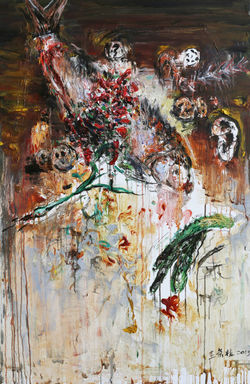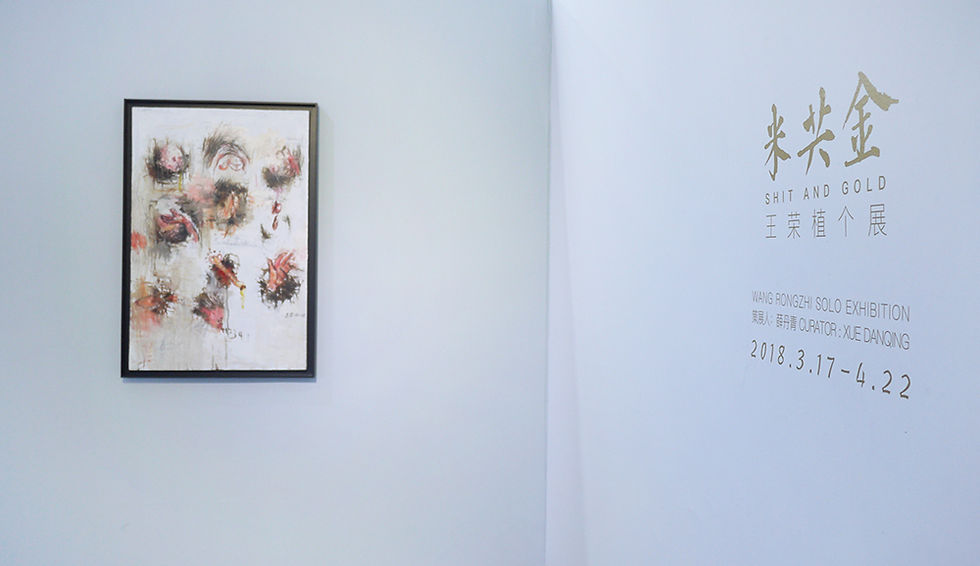
展览 Exhibition
作品 Works
 王荣植 | Wang Rongzhi 野餐 No.2 | Picnic No.2 布面油彩 | Oil on Canvas 160X140CM 2017 |  王荣植 | Wang Rongzhi 巡山 No.2 | Mountain Scouting No.2 布面油彩 | Oil on Canvas 250X140CM 2017 |  王荣植 | Wang Rongzhi 荆棘 | Thorns 布面油彩 | Oil on Canvas 120X150CM 2012-2017 |
|---|---|---|
 王荣植 | Wang Rongzhi 巡山 | Mountain Scouting 布面油彩 | Oil on Canvas 250X140CM 2017 |  王荣植 | Wang Rongzhi 食客 No.3 | Gourmet No.3 布面油彩 | Oil on Canvas 120X80CM 2015 |  王荣植 | Wang Rongzhi 食客 No.2 | Gourmet No.2布面油画 | Oil on Canvas 120X80CM 2015 |
 王荣植 | Wang Rongzhi 生蚝 No.3 | Fresh Oyster No. 布面油彩 | Oil on Canvas 350X50CM 2015 |  王荣植 | Wang Rongzhi 烧烤 | Barbecue 布面油彩 | Oil on Canvas 30X40CM 2015 |  王荣植 | Wang Rongzhi 脑花 | Brain 布面油彩 | Oil on Canvas 40x30CM 2016 |
 王荣植 | Wang Rongzhi 巢 No.8 | Nest No.8 布面油彩 | Oil on Canvas 120X80CM 2015 |  王荣植 | Wang Rongzhi 搓 | Rub 布面油彩 | Oil on Canvas 100X100CM 2014 |
简介 About
米共金
几乎肉眼可见的,我们已经将自己置身于一种社会里,这种社会甚至连金钱社会都谈不上,而只是一种以金钱为抽象象征[1]的社会。当用以衡量财富的地亩和金条被某种数量的交换活动对应的确切数字替代时,原先建立在符号上的社会和由此衍生的普世规则在本质上逐步趋向神秘化,于是社会选择了另一种基于道德共识的原则来维持其运转,从历史辨证的角度来看,这一共识既是宗教,亦是社会主流价值体系。如今我们在国家监狱、血汗工厂、金融庙堂、教育机构、体育赛场等地方随处可见自由、平等、博爱等字样,道德共识获得前所未有的广泛传播,而被神秘化了的以金钱为符号的社会经验和以此为中心的世界运转规则,却从不可见处反噬了道德共识,使其沦为虚有其表的形式,于是“原则上的自由,实际上为一种事实上的压迫服务(语出阿尔伯特·加缪)” 。
弗洛伊德在《人格和肛门驱力》中石破天惊地将肛门驱力和金钱从象征层面进行阐释:从古至今约定俗称的观念中,金钱总是与肮脏密切相关,“拉出金子”或“金子变粪便”等情节不断出现在西方神话故事和迷信传说中,东方亦有“视金钱为粪土”这类强有力的文化渊源来佐证该观念的普适性,而在人体排泄时被表现出来的肛门驱力,作为所有隐喻之所在(the locus of metaphor) ,提示了主体存在与匮乏之间的辩证关系,其本质是——当人不能就所承受的给予同等反馈时,人总是能回馈点别的什么。因此,在当代语境中,可以将肛门驱力和其排泄物视作主体在无法反馈金钱匮乏带来的压抑和沮丧时提供的替代回馈方案,这也是艺术家王荣植针对当前社会之所压抑的、无法正面回应的议题提出的一种解构性答案,这一答案富含自嘲、暗讽和鞭笞,如同一个紧紧攥着的随时准备出击的拳头,又在最后一刻选择温柔放下,展览标题《米共金》即为糅合艺术家的幽默与刚直而来,亦忠实概括了展出作品的反叛内涵。
本次展览架构以艺术家王荣植过去几年创作的架上绘画搭建而成,一直以来王荣植以其标志性的狂野笔触扫描着人类精神文明处被压抑的真实叙事和情感,无论是快速刷过画布表面的象征意识片段的摇滚质感的涂鸦,还是浓墨重彩厚涂出的如同歌剧般浑厚壮丽的刻画,皆真切地反应了其不受拘束又魂魄集中的绘画语言。实际上,架上绘画发展至今,有关技法观念交互关系的探讨早已沦为陈词滥调,在英国艺术家、艺术史学家赫伯特·里德(Herbert Read)撰写的《现代绘画简史》一书中,极为精准地总结了绘画发展至今的状况:首先是对于艺术的具体材料和绘画语言的关注,即为颜料而作画,尤其是杰克逊·波洛克(Jackson Pollock)后的画家们包括马克·罗斯科(Mark Rothko)、巴内特·纽曼(Barnett Newman)和弗兰克·斯特拉(Frank Stella)在内,越发关注色阶和色值。第二种分支则试图在对绘画的探索中植入象征性的形象,以期弥合生活与艺术之间的鸿沟,通常表现为在绘画中加入版画或者照片的原始素材,或将现成品直接挪用到画面中,如贾斯培·琼斯(Jasper Johns),罗伯特·劳申伯格(Robert Rauschenberg),还有鼎鼎大名的安迪·沃霍尔(Andy Warhol)。最后一种则试图让绘画超越其材料,称作作为观念的材料,由伊夫·克莱因(Yves Klein)和皮耶罗·曼佐尼(Piero Manzoni)从欧洲发源再波及全球。
实际上,落实到王荣植的绘画探索,观者能惊喜地发现他在融会贯通的基础上兼而有之。作品《脑花》彰显了艺术家对于颜料使用上的得心应手,高度概括性的抽象笔触拉开距离后诉诸视野的是具体的形象表达;而在《杂耍》、《头像》等多幅作品中,反复出现的黄瓜意象,或直接或隐晦地显示了艺术家对于描绘主体处境的同情,甚至可以从敏感细微处体察到艺术家移情于被描绘对象,以及由此生出的解嘲般的自我宽慰;从整体来看,王荣植的绘画颇具主观能动性牵引下的自动创作方面的开拓性,材料在此不仅仅是观念的载体,亦是后者摆脱前者限制性,走向更为精神性的必须穿越的物质性介质。因此,试图真正精确概括王荣植的创作,还是得回到挖掘其精神内涵上。
从某种程度上来说,艺术家离群索居的生活状态和与主流社会反向逼迫的价值观,令其在形式概念层面游走于社会正统边缘。不妨大胆假设——可能许多当代艺术家是潜在的罪犯,只是当形态各异的犯罪倾向以艺术的形式承载于媒介时,以破坏为主要显征的实质概念被美学化处理,放佛替社会集体情绪找到一个合情合理的出口,又兼容了艺术创作记录历史的使命。王荣植试图对精心粉饰的美好生活进行“卸妆”,通过真实地表现人的喜怒哀乐和吃喝拉撒来抵抗流行于社会的取悦症候群(Overpleasing Syndrome),也许不妨更为大胆地将王荣植的创作视作当下社会的病历卡?在这里,拉康式的三界摩擦都将以一种美学化的形式呈现,在并不冒犯法律的语境下,社会上那些暗流汹涌的犯罪冲动得以堂皇呈现。倘若套用拉康的三界理论(即:实在界、象征界和想象界),以精神分析学的角度来反思王荣植与众不同的精神状态,可以说,得以享受象征界和想象界带来的精神乐趣,是驱使其展开创作的原始动力,而实在界的世俗纷扰,如最起码的生存尊严,又不时将他拖出乌托邦,这其中百般拉扯的痛苦与妥协,旋即通过艺术这一渠道宣泄出来,作品成为合理合法的介质,缓冲了并不完全合情的现实。用拉康的话说:“从压抑的意义上说,所有被象征界拒绝了的东西又重新出现在了实在界之中。”
在王荣植的画面中,人如同被剥去皮囊的动物,暴露在荒野或城市废墟中,行为举止莫名其妙,动机与逻辑无处查证,荒诞性与讽刺性贯穿其创作始终,而现实主义内核则被超写实主义的面纱保护起来,令其作品可以在反应社会现状层面上尽可能地逼近诚实。举例来看,作品《晒肠》综合了卡夫卡式的诡谲与黑色幽默,将排泄之动作进一步升华到更具有挑衅意味的自杀式妥协;而《生蚝》则为观者提供了怪诞的俯视视角,在激活生蚝本身暗含的女性生殖器符号的基础上,将常规性爱动作进行暗示性倒置,重新解构了日常的权力机制,实际上颇具政治性内涵。实际上,王荣植强迫观者仔细分辨画面中的形象,因为他似乎在有意混淆人与动物、猎杀者与被捕食者的区别,这是艺术家以其高度精神性的语言在传达当代社会“人即为刀俎,亦为鱼肉”的苍凉和悲怆。除此以外,王荣植擅长将人物揉搓成贾科梅蒂既视感的又细又黑的去性别化和地域化的“动物”,这一显而易见的创作手段,也从另一个角度佐证了艺术家内心对于人之处境的悲观和同情。
如若非得为王荣植的作品附加任何符合时宜的现实意义,则不得不将其放置到中国当代艺术的整体气候中去,作为一名艺术家,王荣植并没有在本次展览中对于他提出的问题提供任何解决方案,但空间站依然以不道歉的姿态展出这些作品,或者说,艺术家和空间站共同营造了一个叫“弗洛伊德式肛门驱力”(Freudian Anal Eroticism)的魔幻语境,同时并置了以拉康精神分析学(Lacanian Psychoanalysis)为核心的“发疯”维度,邀请观者作不需要负任何现实责任的排泄。如若还要再进一步为王荣植和王荣植们撰写备注,则不妨将目光转至1957年,那天法国存在主义作家加缪获得诺贝尔文学奖荣誉认可,他在受奖演说上发言:"一个人常常因为感到自己与众不同才选择了艺术家的命运,但他很快就明白,他只有承认他与众人相像,才能给予他的艺术和不同之处以营养。真正的艺术家什么都不蔑视,他们迫使自己去理解,而不是去评判。" 法国作家巴尔扎克则以更为简短的语言总结——"天才像一切人,而没有人像他"。
[1] 此概念由加缪于1957年12月14日获得诺贝尔文学后在瑞典乌普萨尔大学的一次演说中提出
Shit and Gold
It is definitely obvious that we have placed ourselves in a society that is not even a money society, but a society that symbolizes money as an abstraction. (This conception was put forward in a speech by Albert Camus after receiving Nobel Prize for literature on December 14, 1957, at the Uppsala University, Sweden.) When the land and gold bars used to measure wealth are replaced by the exact figures corresponding to a certain number of exchanges, the society that was originally built on symbols and the universal rules derived therefrom are gradually tending toward mystification, as a result, the society runs in a set of alternative principles based on the moral consensus, which, from the perspective of historical dialectic, is both a religious and mainstream value system. Now the slogans like freedom, equality, and fraternity have become ubiquitous: in the national prisons, sweatshops, financial administration, educational establishment, sports arenas, etc., and the moral consensus has been spread more widely than ever before. The mystified social experiences with money as a symbol, on which the rules of the world are centered, have nevertheless falsified the moral consensus from the invisibility, degrading it into a form without content; therefore, as Camus put it, “freedom as a principle is actually served as oppression.”
In Character and Anal Erotism, Sigmund Freud unexpectedly interpreted the intimate relationship of anal eroticism to money on the level of symbolism: money is always related to dirt in the received conceptions from ancient times to the present. Discharging gold from the body, gold’s turning into feces, and others of that ilk recur in Western myths, fairy tales, and superstitions; in the East, seeing money as dirt such as expression also prove the universality of this conception. Anal erotism in excretion, as the locus of metaphor, indicates the dialectical relationship between the subject’s existence and beggary, the essence of which consists in that one might always give something else if cannot give the same feedback for what he bears. Therefore, in the contemporary context, anal erotism and its excretion can be seen as an alternative if the subject cannot alleviate the repression and depression incurred by the lack of money, and it is a deconstructive answer that artist Wang Rongzhi gives in view of the repressed issues that cannot be responded positively in the current society. The answer, with self-mockery, innuendo, and scourge, is like a clenched fist ready to attack but comes to a gentle lay-off in the last moments. The title of the exhibition Feces and Gold blends Wang’s humor and outspokenness and suggests the connotation of rebellion in the exhibited works.
The frame of the exhibition organizes in Wang’s easel paintings created over the past few years. Wang has been scanning the repressed real narratives and emotions in human spiritual civilization with his characteristically wild style. All the drawings, whether the graffiti of rock texture, standing for the consciousness fragments, quickly brushing against the canvas or the opera-like majestic depiction in thick brush, truly reflects his unrestrained and soul-centered drawing language. As a matter of fact, the discussion on the interactive relationship between drawing techniques and related concepts has hitherto been a cliché. In the book A Brief History of Modern Painting written by Herbert Read, a British artist and art historian, the development of painting so far was summarized with great precision: first, attention is paid to the specific materials of art and the language of painting, i.e., painting for paints; painters after Jackson Pollock, including Mark Rothko, Barnett Newman, and Frank Stella, are paying more attention to the color scale and color value. The second branch attempts to implant symbolic images in the exploration of paintings in order to bridge the gap between life and art, which is usually expressed by adding to paintings original material of prints or photographs or ready-made products, as Jasper Johns, Robert Rauschenberg, and famous Andy Warhol do. The last attempts to make painting beyond its material, known as material as ideas, originated from Europe by Yves Klein and Piero Manzoni to the world.
In fact, as to Wang’s exploration of paintings, there could be a pleasant surprise for viewers that Wang has a combination of the characteristics mentioned above. Brain Flower highlights Wang’s ingenious use of paints: what comes into vision is a concrete image when viewers are distanced from the picture by the highly generalized abstract stroke. In many works, such as Juggling and Head Portrait, the recurring image of cucumber, either directly or implicitly, shows the artist’s sympathy for depicting the situation of the subject, and it could even be found that his empathy with the depicted object, and hence the sardonic self-relaxation from it. From the perspective of totality, his paintings have the pioneering nature of automatic creation under the influence of subjective initiative. The material here is not only a vehicle for ideas but also a material medium through which the latter is free from the limitations imposed by the former and has to move through in order to reach more spirituality; therefore, trying to summarize the creation of Wang Rongzhi still has to go back to excavating its spiritual connotation.
To some extent, artist’s isolated conditions and the coercive values of mainstream society make him walk on the edge of the social orthodoxy on a formal conceptual level. It might be a bold assumption that many contemporary artists may be potential criminals, but when the various criminal tendencies are carried in the media in the form of art, the essence concept mainly characterized by destruction is aesthetically treated, as if social collective emotions find a reasonable vent, which is compatible with the mission of art record history. Wang tries to take off the make-up for the elaborately fabricated good living and to resist the Overpleasing Syndrome prevalent in the society by authentically expressing human emotions and ordinary life. Shall we see Wang’s creation as a medical record for the current society? Here, the Lacanian three orders friction will be presented in an aesthetic form. In the context of not offending the law, the turbulent criminal impulses in the society can be presented. Applied three orders theory (i.e., the real, the symbolic, and the imaginary) and reflected on Wang’s distinctive spiritual state from the perspective of psychoanalysis, we might say that what makes him find the spiritual joy from the symbolic world and the imaginary world is the primitive force that drove his creation, and that the secular turmoil in the real world, such as the minimum dignity of living, drags him out of Utopia now and then, in which the twisted pains and compromises are immediately vented through the art channel: works become a legitimate medium, buffering the reality that is not completely rational. As Lacan put it, “In the sense of repression, all things rejected by the symbolic world have reappeared in the real world.”
In Wang’s pictures, people are exposed as animals whose skins have been stripped in the wild or urban ruins. Behaviors are inexplicable. Motivation and justification have nowhere to verify. His creation was permeated by absurdity and satire, while the veil of hyperrealism covers the realist kernel so that his works can be as close as possible to honest in responding to the social reality. Sharing Bowels, for example, combines Kafka-style slapsticks and black humor, raising excretion to more provocative suicidal compromise; providing viewers with grotesque overlooking, Oyster,based on the activating female genital symbols implied by oysters themselves, suggestively turns upside down the conventional sexual movements, reconstructing the power mechanism with a political connotation. In fact, Wang forces viewers to distinguish the images in the picture, since he seems to confuse the differences between human and animal intentionally, which suggests the desolateness and sadness of the idea that one is both hunter and prey the artist tries to convey in highly spiritual language. Moreover, Wang is good at rubbing characters into Giacomettian animals, black and thin, dehumanized and de-territorialized. This obvious creative method, from another angle, also proves the artist’s inner pessimism and sympathy for the human condition.
If it is necessary to attach any realistic meaning to Wang’s works, they must be placed in the climate of contemporary Chinese art. Wang Rongzhi, as an artist, does not provide any solution for his questions in this exhibition; however, Space Station still displays these works without apologies. Alternatively, the artist and Space Station jointly created a magical context called Freudian Anal Eroticism and juxtaposed a dimension of madness taken Lacanian psychoanalysis as the core, inviting viewers to excrete without taking any responsibility. Written further notes for Wang Rongzhi or artists like him, you might turn your gaze to a day in 1957, when French existentialist writer Camus won the Nobel Prize for literature and spoke at the prize presentation, “one often feels that he chose the destiny of being an artist for his idiosyncrasies, but he soon realized that only by acknowledging that he was similar to others he could feed his art and idiosyncrasies. The real artists did not despise anything, and they forced themselves to understand rather than to judge.” French writer Honoré de Balzac put it more briefly: genius is like everyone, and no one is like him.
#米共金#ShitandGold
北京市朝阳区酒仙桥路4号
798艺术区中一街
空间站
Space Station
4 Jiuxianqiao Rd, 798 Art Zone,
Chaoyang District
Beijing 100015
+86 10 59789671
spacestationart@163.com
开放时间:
周二至周日10:00 - 18:00
Opening Hours:
Tuesday-Sunday 10:00 - 18:00
艺术家 Artist:
下载 Download:







